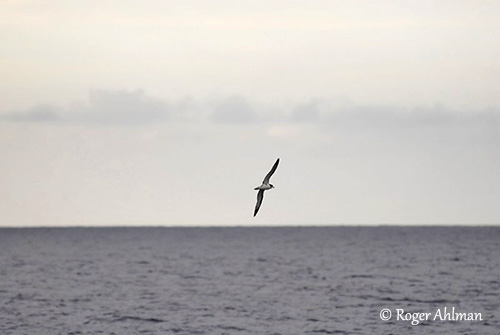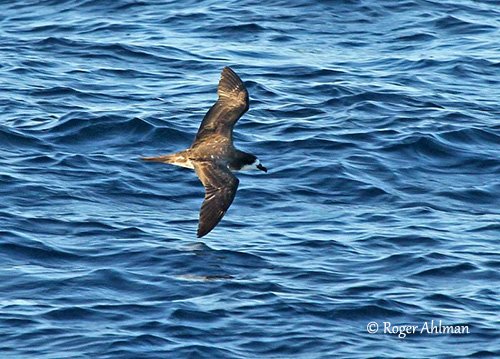
Fr: Pétrel des Galápagos
Ang: Galapagos Petrel
All: Galápagossturmvogel
Esp: Petrel de Galápagos
Ita: Petrello delle Galapagos
Nd: Galápagosstormvogel
Sd: galápagospetrell
Photographer:
Roger Ahlman
Pbase Galleries Peru and Ecuador
Text by Nicole Bouglouan
Sources:
HANDBOOK OF THE BIRDS OF THE WORLD vol 1 by Josep del Hoyo-Andrew Elliot-Jordi Sargatal - Lynx Edicions - ISBN: 8487334105
Petrels, Albatrosses, and Storm-Petrels of North America: A Photographic Guide De Steve N. G. Howell – Editor: Princeton University Press, 2012 – ISBN: 0691142114, 9780691142111 – 482pages
OISEAUX DE MER – Guide d’identification de Peter Harrison – Editions Broquet (Canada) – ISBN-10 : 2890004090 – ISBN-13 : 978-2890004092
Galápagos: A Natural History Second Edition De John Kricher, Kevin Loughlin – Editor: Princeton University Press, 2022 – ISBN: 0691217246, 9780691217246 – 480 pages
Center for Biological Diversity
Assessing the potential impact of wind turbines on the endangered Galapagos Petrel Pterodroma phaeopygia at San Cristóbal Island, Galapagos
International Conservation Fund of Canada
Burrowing for the Future: Galapagos Petrels Are Nesting
Wikipedia, the free encyclopaedia
Page family Procellariidae
Summary cards
Galapagos Petrel
Pterodroma phaeopygia
Procellariiformes Order –Procellariidae Family
INTRODUCTION:
The Galapagos Petrel is part of the “gadfly” petrel group, with its long wings and unique flight pattern.
It breeds on Galapagos Islands in steep areas, usually above 300 metres. It typically nests in excavated burrows or natural holes. Both adults share the nesting duties. It is an endemic breeder of the Galapagos Islands.
The Galapagos Petrel forages at sea around the islands. It feeds on squid, fish and crustaceans, caught by surface seizing or on the wing by dipping.
The species is threatened by invasive species, especially rats, causing important nest failures. The Galapagos Petrel is currently classified as Critically Endangered.
DESCRIPTION OF THE BIRD:
Biometrics:
Length: 40-42 cm
Wingspan: 99-110 cm
Weight: 390-434 g
The Galapagos Petrel has dark grey-brown upperparts, upperwing and uppertail. Mantle and scapulars may show pale edges to feathers, giving the bird a scaly appearance. We can see a poorly defined blackish M pattern on the back, but it is not really distinct.
The tail is blackish to grey-brown, and shows a faint white band on the rump, and sometimes some white spots on the bases of the lateral uppertail-coverts. However, this pattern is often broken, and the typical white “horseshoe” is not well visible.

The underparts are mostly white, but on the underwing, the dark tips of the flight-feathers form a dark trailing edge and a broad blackish wing tip. The dark leading edge extends in a diagonal line to the wing centre. The axillaries may show a small, indistinct dark patch, although it may be large and conspicuous depending on individuals.
When the tail is folded, it appears long, thin and tapered to a point. The undertail-coverts are white.
On the head, forehead, lores, cheeks, chin and throat are white. Crown, head sides, most of ear-coverts and back to mid-neck are blackish, the latter forming an incomplete, broad dark collar on neck sides.
The short, hooked bill is black. The eyes are blackish. Legs and base of webbed feet are pale pink, whereas the distal half of feet and upper surface of outer toes are blackish.
Male and female are similar.
The juvenile resembles adult.
RANGE:
The Galapagos Petrel breeds on several Galapagos Islands including Santa Cruz, Floreana, Santiago, San Cristóbal and Isabela, and probably elsewhere.
Outside of breeding season, it disperses across the eastern tropical Pacific, but the full extent of its at-sea range is unclear, due to similar species, especially the very similar Hawaiian Petrel.
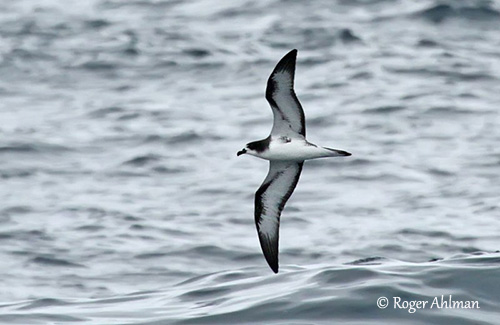
HABITAT:
The Galapagos Petrel breeds in rocky, volcanic areas in the Galapagos Islands. This type of terrain provides numerous natural cavities for nesting sites, excavated or not by the birds. This species usually breeds on high ground, between 180 and 900 metres of elevation.
The nest is in excavated burrow, but lava tubes, caves and sinkholes are also used when available. The area is densely vegetated with native plant species, although some exotic introduced plants may become invasive.
During the non-breeding season, the Galapagos Petrel forages at sea around the nesting islands, including waters just offshore from NW Peru and SW Ecuador.
CALLS AND SONGS: SOUNDS BY XENO-CANTO
When at the colonies, the Galapagos Petrel produces deep growls and wheezy, squeaky yelps.
The main call “kee-kee-koo” includes a drawn-out final note often followed by more final notes. This species has a total of seven types of vocalizations. The males usually produce “sweet” calls, whereas the females give “coarse” calls.
Existence of dialects is suspected within the nesting islands.
BEHAVIOUR IN THE WILD:
The Galapagos Petrel forages mainly during the daylight hours. It feeds on squid, flying fish and also crustaceans pushed to the surface by large fish such as tuna and porpoises.
It takes the prey by surface seizing or while flying low and dipping.
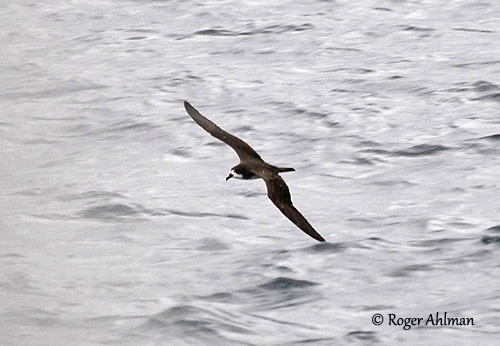
The Galapagos Petrel returns to the islands for breeding. The nest is excavated or the birds use existing natural holes in the rocky, volcanic terrain.
They fly into the nesting areas after sunset. During the night, they perform aerial displays consisting of noisy, acrobatic flights. The noise is usually heard into the wee hours of the night.
A single egg is laid and both parents share the nesting duties.
Following the breeding season, the Galapagos Petrel disperses across the eastern tropical Pacific, but this range remains unclear.
It is a rare non-breeding visitor to seas of Middle America, and there are records from Baja California. It has been recently confirmed in Peruvian waters, off the coast of Arequipa.
The Galapagos Petrel is part of the “gadfly” petrel group for its erratic twisting and turning flight.
While flying in calm weather, the flight consists of 3-4 wingbeats followed by a long glide on bowed and angled wings. But in strong wind, the bird glides in long arcs and high above the water surface, while the wings are bowed.
When seen at a distance, the flight pattern is described as “buoyant” as the bird rises and falls in the air.
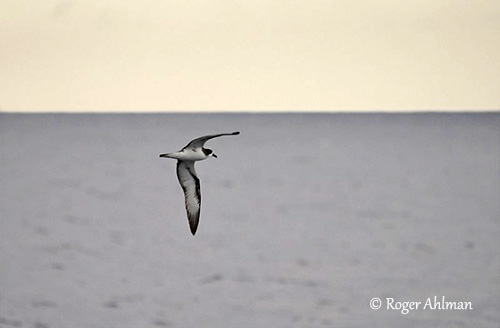
REPRODUCTION OF THIS SPECIES:
The breeding season is highly variable, sometimes protracted. The nesting season runs from mid-April through October, with peak in August.
The Galapagos Petrel has long-term pair bonds usually maintained between years. Numerous burrows are reused in several following years.
The species is colonial breeder and nocturnal over land.
The nest is an excavated burrow, or other natural holes, crevices or hollows in lava. The nesting site is usually in banks of watercourses, and densely vegetated with endemic plant species (Miconia) and a variety of native ferns.
Some additional material such as twigs, leaves and moss are collected by the adults to complete the nest.
The laying follows a pre-laying exodus of about 34 days. The female lays a single white egg. The incubation lasts 46-53 days, shared by both adults, in shifts of 10 days (maximum 17 days) and 4-6 changeovers.
At hatching, the chick has dusty brown-grey down. It is fed by regurgitation during the first three months. The fledging period lasts 98-108 days, depending of the island. Then, the young bird finally ventures out to sea.
It spends years out in Pacific Ocean, and comes back to land only when it is mature and ready to breed.
The breeding success is often low, mainly due to predation by rats.
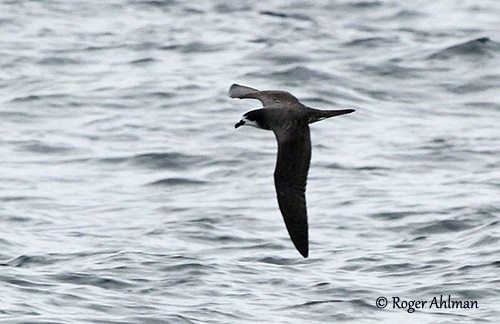
PROTECTION / THREATS / STATUS:
The Galapagos Petrel is affected by introduced predators and expansion of agriculture on the nesting islands.
The main predators are Brown and House rats, but cats, dogs and pigs still represent a significant threat on some islands where they are still present, involving predation of eggs, young and adults.
Native species such as the Short-eared Owl and the Galapagos Hawk also have a negative impact, especially on adults.
El Niño event can affect both nesting success and food resources.
However, most of breeding sites are now within Areas of Conservation, the colonies are protected by fences, and the livestock is removed from the area.
The global population is placed in the band 10,000/19,999 individuals, equating roughly to 9,000/10,000 mature birds (2008).
The species is declining rapidly, and the Galapagos Petrel is currently classified as Critically Endangered.
